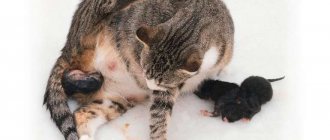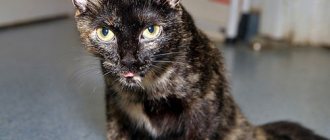The approaching birth of a cat causes anxiety for both the animal and the owner. After seven weeks, the veterinarian indicates the exact date of birth, which allows you to properly prepare for it. Possession of information about the stages of labor, calmness and support for the animal contribute to a favorable outcome and well-being of the mother and kittens.
What to prepare?
The first signs of labor in a cat do not come as a surprise. The responsible owner will begin preparations at least a day before labor. There are two options for delivery: at home or in a clinic under the supervision of a veterinarian. The chosen place for birth in a hospital does not require special preparation. Symptoms of contractions or the pushing themselves provoke an immediate trip to the doctor. When a cat has given birth, it is enough to ensure maximum peace and favorable conditions for the nursing pet.
Giving birth to a cat at home involves a thorough preparatory process. To know more about the course and stages, it is recommended to consult a veterinarian. The doctor makes a list of medications that may be useful and assesses the general condition of the animal. Possible medications include injections that can stimulate and speed up labor or pain-relieving injections. In addition to the medication component, it is recommended to prepare a place for childbirth at home, which will have sheets and a warm corner for the babies. Gloves are appropriate and sterilized cord threads should be prepared in advance.
Stimulation of contractions
Childbirth is a very stressful and time-consuming process that can be complicated for a number of reasons. Weak labor activity is a serious threat to the life of the offspring and the mother in labor. As soon as you find out that your cat is pregnant, you need to take her to the veterinarian for a comprehensive examination. If the cat has a predisposition to difficult childbirth or questionable heredity, after establishing the gestational age, a date for a planned cesarean section is set.
After visiting the veterinarian, when the estimated date of birth has been established, it is advisable to arrange a home visit with the doctor. You may not need the help of a veterinarian, but if the birth occurs on a weekend, at night, or with complications, it will be very difficult to find a veterinarian. In addition, transporting a cat that is giving birth is a very serious stress that can lead to the termination of labor.
The beginning of the first contractions is not an indicator of the normal course of labor. It happens that a cat is in contractions for more than 12 hours, but never moves into the pushing stage. In this case, labor stimulation is used. Stimulation begins with intense stroking movements on the cat's mammary glands and abdomen. If the body responds to stimulation, contractions should become longer and deeper.
If no external manipulations produce results, Oxytocin . The drug is administered in a dose of 0.3 ml (per medium-sized cat) every hour until pushing occurs or contractions return. Oxytocin is not recommended to be administered more than 4-5 times, since contractions may stop if the kitten gets stuck in the birth canal. In such a situation, stimulation will lead to damage to the walls of the uterus and birth canal.
Oxytocin is considered a universal and very effective remedy, but it does not always help. If your cat doesn't start pushing or contractions don't return, your veterinarian may recommend an emergency caesarean section. The course and outcome of the operation, in this case, are unpredictable. If the birth began on time, but occurred with complications, the chances of saving the offspring are quite high. During surgery, the veterinarian may remove the uterus if it has been damaged or genetic pathologies are detected.
Based on experience, cats that have undergone cesarean section and castration recover much faster. However, there is also a negative side to the complex operation - after removal of the uterus, the cat may stop lactation, that is, the kittens will have to be fed artificially.
Harbingers and signs
About a week before the planned date of birth of kittens, it is worth starting to monitor the body temperature of the expectant mother.
Signs of imminent labor in a cat are accompanied by external changes. A responsible and observant owner will also notice the animal's restless behavior. Veterinarians recommend monitoring your cat's rectal temperature 5-7 days before the expected date. Immediately before the start it drops to 37 °C. A very drooping belly will help you find out that your cat is in labor. A sharp loss of appetite occurs 1-2 days before the birth of kittens.
In first-time mothers, there is a decrease in activity: the expectant mother practically does not walk or drink. The day before the start, the cat becomes restless and begins to look for a place to lamb. In this case, you need to indicate to her the nest prepared in advance. The cat's body is characterized by the presence of a mucus plug. In a pregnant cat, it comes out 2-3 hours before birth and is a 100% precursor to the start of labor.
Pregnancy
Normal cat pregnancy, like canine and female pregnancy, occurs in three stages:
recommended articles:
- How many kittens does a cat give birth to for the first time?
- What is eclampsia in cats?
- The first 20 days after mating pass without signs of pregnancy. At the end of the period, swelling of the loop, increased drowsiness, and decreased appetite are observed.
- At the second stage, pigmentation of the nipples is noticed, becoming bright pink. The cat is petting and requires increased attention. By the six-week period, the female becomes round; when palpating the abdomen, the movement of the embryos is felt. Pregnancy toxicosis may occur. manifested by vomiting.
- The last trimester is characterized by an increase in the cat's size. She sleeps more and becomes gluttonous. During sleep, you can see the kittens frolicking inside the mother. The nipples swell and begin to secrete colostrum. The mucus plug that covered the cervix comes off. The cat begins to nest.
The mammary glands are preparing for childbirth.
As a result of targeted human selection, the nature of the animal has changed. Some cats have lost the ability to nest, relying on their prudent owner for everything. Such individuals are predisposed to nervous breakdowns, which leads to premature lambing or abandonment of kittens.
Stages of labor
The birth of kittens can be divided into the onset of labor and the delivery itself. Knowing how they go, what the problems may be, how important aftercare is, will keep the mother and offspring healthy. Labor can last up to 8 hours, with short breaks. Duration beyond the specified time is fraught with negative consequences. It is noteworthy that the first birth may slightly increase the timing of one of the stages.
Start of labor
At the initial stage of the process, the animal’s breathing is rapid, and the body position is on its side.
Contractions in a cat make it clear that the pet is about to give birth. At this time, the uterus expands and provokes the removal of the mucus plug. When you lightly press the nipples, a clear liquid should be released - colostrum. The cat meows and lies on its side. The large belly drops and the pet breathes frequently. Childbirth in an animal may be accompanied by vomiting and complete refusal of fluids. You can do a light massage along the spine.
The animal looks tired and slightly discouraged. This behavior of a cat before giving birth is explained by pain. Delivery of a firstborn is facilitated with the help of Oxytocin. It can also cause contractions. The injection is given at the withers according to the recommended dosage. For better dilation of the uterus, you can use a drug called “No-Shpa”. Training contractions are clear harbingers of the start of labor.
Labor activity
The cat gives birth in a specially designated area. During childbirth, the pet becomes aggressive, yells and may bite. You need to behave calmly with the animal and not raise your tone. At the same time, attempts and discharge appear. They may contain small amounts of blood. At this moment, it is important not to miss the beginning bleeding. The appearance of approaching kittens is accompanied by contractions. At the same time, the stomach “waves” and the body bends. Weak labor is a common symptom. It can be determined by the fact that the cubs take a long time to walk and the lambing time increases.
Each baby is born in a special bubble.
The normal course and duration flow into labor itself. An amniotic sac emerges from the uterus, containing one kitten. A common occurrence is when a pet comes out without breathing. The owner immediately breaks the bubble and removes all the liquid from the mouth. You have to be quick with time, otherwise the kittens will die. The break and interval between kittens is used to dry the babies. At this point the mother can regain her strength. Place the babies in a box with dry diapers and a heating pad at the bottom. After the kitten comes out the placenta. If it remains inside, problems are likely. When the cat begins to push again, all attention should be given to her and the rest of the babies should be accepted. When labor has stopped, the kittens are applied to the nipples. We should not take our pet to the veterinarian.
Postnatal care for the cat and offspring
For the first few days after lambing, it is necessary to maintain a relatively stable temperature in the “cat house” (about 28-29 degrees). You should ensure your cat has an easily digestible diet. This can be a “light” feed five times a day, as well as an abundance of dairy products to replenish the calcium lost by the animal. Among other things, you should take care of sufficient drinking regime.
It was previously mentioned that the length of time a cat bears kittens largely depends on the breed of the animal. Many people are interested in how long pregnant British cats walk, since the breed is quite common and owners are afraid of missing the most important moment of lambing. When asked how many days a cat carries British kittens, we can answer that the duration of pregnancy in British cats is about 63-70 days. It is noteworthy that specialists in some veterinary clinics do not know that the duration of pregnancy in cats depends on the breed and, if they suspect a delay in lambing, they resort to cesarean section. That is why owners should study all the intricacies of this process themselves in order to be informed.
Another interesting question: how long do pregnant Scottish cats walk? This breed usually survives for about 62-65 days. But the record holders are considered to be Siamese cats, whose lambing most often occurs on the 58-60th day.
A cat is ready for pregnancy already at 8-9 months of life, but experts do not recommend taking your pet for mating before a year.
Owners should prepare for lambing in advance: they should monitor how many days pregnant cats walk, pay attention to the behavior of the pet and provide the necessary assistance in a timely manner directly during childbirth. If you are not sure that the assistance will be provided with high quality, it is better to agree in advance with the veterinarian about the possibility of coming. Read more about care after lambing in the article “Cat with kittens: proper care after birth.”
Complications and how to help?
The cat's behavior after giving birth indicates its general well-being.
If the female is engaged in licking the emerging offspring, then there is no need to rush to the doctor.
If the pet has lambed, feeds and licks the kittens, then she can be taken to the veterinarian within 2-3 days. Otherwise, you should immediately consult a doctor. The veterinarian will give advice and prescribe treatment for the cat. Ignoring the fact that a cat breathes quickly and intermittently, eats poorly and strains has a serious impact on its health. Veterinarians name cases when a woman in labor died due to the irresponsibility of the owner.
During childbirth
Obstetrics of first-time cats requires careful monitoring by a doctor. Multiparous women have experience and the animal tolerates contractions more easily. During a home birth, you should prepare for possible difficulties:
- A common occurrence is that the afterbirth does not come out. To prevent it, it is necessary to control their intake.
- You should intervene when two kittens climb at once. It is recommended to carefully adjust the amniotic sacs and push them towards the exit of the baby. At the same time, the second one “rolls” along the fallopian tubes and gradually comes out.
- If the babies died during labor, and the bladder is sticking out from the cat, you should immediately remove it. All movements become soft, guaranteeing maximum care.
- The amniotic space without kittens inside does not pose a health hazard. If she wants, the woman in labor can eat the contents between contractions. Vitamins will help the animal prepare for the birth of the baby, and their smell will provoke acceptance of children.
- If contractions started, but stopped after some time. In this case, induce labor in the cat using medication. Your veterinarian will tell you what the medications are called.
- The attempts last for more than 26 hours, and not a single kitten appears - a dangerous symptom. The likely cause is false contractions, the large size of the babies, or incorrect position of the amniotic sac.
After childbirth
Sometimes it happens that a pet does not perceive her babies, which is why they may not survive.
Severe complications plague the animal during delivery and after the birth of kittens. Possible problems with the body may include:
- Difficulty breathing caused by the release of hormones.
- After giving birth, a cat does not eat for the first 1-2 days. Lack of appetite in the immediate hours after delivery is not dangerous. If the cat has lost a lot of weight after giving birth, constantly meows and refuses to eat, you should show your pet to a veterinarian. The reason may be pain and health problems.
- Aggression towards cubs is more common in first-time mothers. This is a purely psychological problem (especially typical for British mothers), which leads to the death of kittens due to the lack of maternal warmth and milk. The owner helps with treatment and a special regime. The veterinarian determines how to treat.
- The cat limps after giving birth due to pain. It should be treated by a doctor with painkillers.
How to prepare for childbirth
The first thing you need to do before giving birth is to prepare the “ward”. This is where the cat will give birth, and where she will spend the next few weeks with her kittens. Typically, cat owners equip a regular cardboard box as a birthing area.
When choosing it, you need to be guided by the following indicators:
- Accessibility means that you cannot take a box with high sides, or you just need to cut it off. Since it will be extremely inconvenient for a woman in labor to climb over high barriers;
- Size – it should not be too small or large. Expect that the cat will move around inside it, and then live with the kittens;
- Position – Place the structure in a quiet place so that the cat has some space of its own. This could be a closet, a corner of the bedroom, a bathroom, or other unoccupied areas of your home.
If you do not create a special place, or your cat does not like it, she will run after you or hide in a place where you cannot help her, which will endanger both the mother and her offspring. There should be bowls for drinking and food nearby, as well as milk powder for kittens. It is better to move the cat's litter box closer.
"Alarm suitcase"
In order for you to be prepared in that very case, collect an “Alarm Suitcase” in advance (as with women during childbirth). The contents of the suitcase may be different, depending on your capabilities and competencies. These are mainly: surgical gloves, sterile towels and tissue, cotton wool, wet wipes, medical thread, pipette, bulb or small syringe. As for medications, you should put in there a liquid antiseptic, healing ointments like Levomikol, Vaseline, oxytocin, potassium gluconate, and other products.
What to do during childbirth
So, you have prepared the place for the birth, the cat is in place, the “Alarm suitcase” is at hand. You see that the cat has begun to arch, you can feel with your hands how the abdominal muscles are contracting - these are contractions. Usually, after 1.5-2 hours of active contractions, the first fetus appears.
IMPORTANT: If more than two hours have passed since the start of active contractions, the cat is straining, she has brown discharge, but there are still no kittens, then this is a reason to contact a veterinarian. This situation occurs when kittens are stuck and cannot get out.
When should I start reporting? The first signs of the onset of labor
- The cat's stomach drops;
- She begins to urinate frequently and her water breaks;
- The birth plug separates and discharge begins;
- Naturally, the cat begins to breathe frequently.
If you observe these symptoms, labor has begun. Under normal natural conditions, cats give birth on their own. But you should be on your guard, because at any moment something can go wrong.
Correct care for a woman in labor
In the wild, cats give birth on their own, but in domestic cats, their natural instincts are muted. For this reason, it is desirable that the owner be nearby during childbirth and can provide the necessary assistance in a timely manner. It is especially needed for a cat giving birth for the first time. The pet can only guess what will be required of her. The owner’s task is to act competently and, if necessary, call a veterinarian.
Correct actions with the amniotic sac
If the bubble with the kitten inside is not damaged, if the fetus lies correctly head first, then your help will not be required. You need to intervene in the following cases: - if the bubble is torn, prepare a clean cloth, wrap it around the kitten and gently pull at the next contraction; - if the bladder is torn and the kitten is walking butt, pull without waiting for a contraction, speed is more important so that the baby does not suffocate.
If the cat does not chew the amniotic sac, this must be done for her. You will need sterile scissors. Act quickly - if you wait more than half a minute, the kitten may suffocate.
If the kittens are too big
It is difficult for a cat to give birth to large babies. It will also be difficult for you to remove the kitten; it will slip back into the vagina. If your cat's vulva is dry, lubricate it with Vaseline or lubricant. Proceed as follows: - wait for the next contraction when the baby approaches the vulva; - insert the index finger of a sterile-gloved hand into the vulva a few centimeters and move the skin towards the anus; - as soon as the kitten appears, grab it and move it slightly to help it come out. Determine the intensity of the impact yourself individually.
What to do if a kitten gets stuck
A few hours before birth, kittens take a forward-facing position. But sometimes babies change position or their head is turned to the side, making it difficult to exit the vulva. To help a stuck kitten be born, lubricate the vulva with lubricant or Vaseline and with a sterile gloved hand perform the following manipulations: - carefully insert your finger into the baby’s mouth, if the amniotic sac allows it; — turn the kitten’s head in the right direction so that the cat’s contractions push it further; - press on the cat's perineum at the bottom of the anus - this will cause a contraction, and the baby will not be able to return back.
We do the same if the kitten moves forward with its sacrum - grab it by the paws and guide it along the birth canal.
It happens that for some reason kittens die in the womb. In this case, they will still be born naturally. The cat will go into labor, and if your help is needed, you can act less carefully. It is important that everything is in order with the cat, so if the fetus is stuck, feel free to pull on any part of the body.
Complications in childbirth after cesarean section
There is an opinion that in our time not a single woman or child dies from uterine rupture. Why are doctors so afraid of women giving birth with a uterine scar?
Speaking about the risks of uterine rupture along the scar, you need to understand that provided that childbirth is carefully managed in a specialized hospital, the risks are minimal. However, low risk does not mean no risk. The likelihood of uterine rupture along a scar increases in women in labor:
- with large fruit
- during labor activation with oxytocin,
- with a scar after two or more caesarean sections,
- with a scar after a corporal caesarean section,
- in case of a complicated course of the postoperative period (with endometritis),
- when using prostaglandins.
If you still have questions, you can ask your obstetrician-gynecologist online in the Doctis application.











